
An Overview of Regular Sow Gestation Crate Types
Sow gestation crates, also known as gestation stalls, are a fundamental component of intensive pig farming. They are designed for the individual management of pregnant and non-pregnant (open) sows. By restricting the sow’s movement, these crates facilitate controlled feeding during early pregnancy, simplify heat detection, and help promote successful embryo implantation.
1. Dimensions & Materials
To accommodate different sow breeds, sizes, and parities (gilts, primiparous, and multiparous sows), gestation crates come in various standard dimensions.
Common Lengths: 2000mm, 2100mm, 2200mm, 2300mm, 2400mm.
Common Widths (Center to Center): 500mm, 600mm, 650mm, 700mm.
Materials & Framing:
Round Tube Crates: Constructed from 1-inch tubing with 4-way or 6-way connectors. The combination of 6-way and 4-way connectors is currently the most common configuration.
Round Steel Crates: Built from materials like 20mm or 18mm round steel, typically welded with 14-way or 16-way connectors for high durability.
Hybrid Crates: Combinations of round tube and round steel are also available.
2. Classification by Gate Design and Feeding System
The primary classification of gestation crates is based on the animal flow (entry/exit) and the type of feeding trough used.
Type 1: Rear-In, Rear-Out Crate
Design: The sow enters and exits from the rear of the crate. The front gate is typically fixed with three or four horizontal bars. The rear gate consists of two hinged semi-circular doors for easy operation. This design is highly adaptable to various concrete slat widths.
Feeding & Watering: Used with a through-the-trough (longitudinal trough). This trough has a high front lip to minimize feed wastage and is often suspended for easy cleaning underneath. It is commonly equipped with a water level controller and drinking spouts for efficient water use.
Type 2: Rear-In, Front-Out Crate (with variations)
This is a highly common type where the sow enters from the rear and exits through the front. It has several sub-categories:
Variant A: With Single Trough
Design: Features independent vertical front and rear gates.
Feeding & Watering: Used with a single-space trough. Water is provided via a drinking bowl or a separate drinking spout.
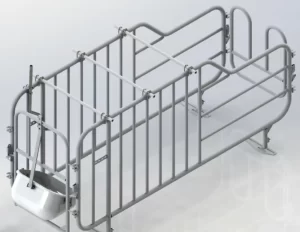
Variant B: With Full-Length Trough
Design: Features independent vertical front and rear gates.
Feeding & Watering: Used with a full-length M-shaped trough, which is either fixed to the floor or supported by legs at the front. The height of the trough’s front edge is influenced by the gate height. A water level controller can be installed.
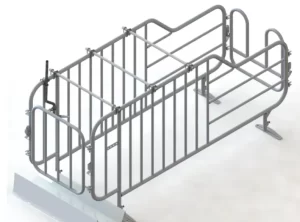
Variant C: With Tilted Front Gate and Full-Length Trough
Design: Features independent gates, with the front gate tilted and integrated with a feed drop pipe.
Feeding & Watering: Used with a full-length trough. A water level controller is typically used for drinking.
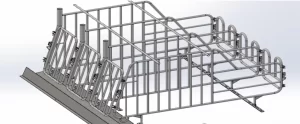
Variant D: With Rear Flip-Up Gate
Design: Features a vertical front gate and a rear gate that flips upwards.
Feeding & Watering: Offers flexibility, as it can be paired with either a single trough or a full-length trough.
Type 3: Other Specialized Styles
American-Style Round Steel Crate: Constructed from a combination of angle iron, round steel, and flat iron, known for its robust, welded construction.

Free-Access Stall: Utilizes a linked mechanism that automatically locks the stall once the sow enters to feed. The door unlocks when she backs out. Stalls can be locked individually or in groups via a mechanical linkage, allowing sows freedom of movement while enabling controlled feeding.
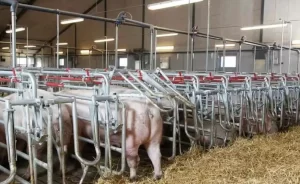

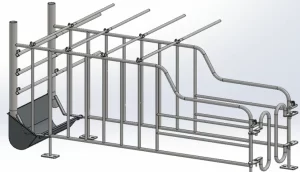
近期评论